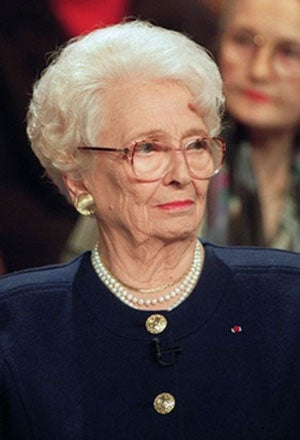Briefly: Christiane Desroches Noblecourt

Your support helps us to tell the story
From reproductive rights to climate change to Big Tech, The Independent is on the ground when the story is developing. Whether it's investigating the financials of Elon Musk's pro-Trump PAC or producing our latest documentary, 'The A Word', which shines a light on the American women fighting for reproductive rights, we know how important it is to parse out the facts from the messaging.
At such a critical moment in US history, we need reporters on the ground. Your donation allows us to keep sending journalists to speak to both sides of the story.
The Independent is trusted by Americans across the entire political spectrum. And unlike many other quality news outlets, we choose not to lock Americans out of our reporting and analysis with paywalls. We believe quality journalism should be available to everyone, paid for by those who can afford it.
Your support makes all the difference.Christiane Desroches Noblecourt, who died on 23 June aged 97, was a pioneering Egyptologist who prodded General Gamal Abdel Nasser to help salvage Nubian antiquities.
Born in 1913 in Paris, Desroches Noblecourt (left, AFP/Getty) developed a passion for Egypt after reading about the discovery of King Tut's tomb in the 1920s. She later studied at the Louvre and the Sorbonne. After an initial trip to Egypt in the late 1930s, she became the first woman to be put on a stipend with the Cairo-based French Institute of Oriental Archaeology.
After Egyptian officials began planning the Aswan High Dam project on the Nile in 1954, Desroches Noblecourt met Nasser to air concerns that 32 ancient temples and chapels in southern Nubia were facing submersion. In an interview in 2007, she recalled how she told him, "Let me handle it, I'll go talk to Unesco on your behalf. He trusted me and let me do it. He was brilliant." Unesco helped mobilise nearly 50 countries for a project in the 1960s to dismantle, move and reconstruct the antiquities, including massive statues of Pharaoh Rameses II at Abu Simbel, which were broken down into 1,000 pieces and rebuilt over four years. She also helped organise a Louvre exhibit in 1967 about King Tut's treasure that drew more than a million visitors.
During the Second World War, Desroches knew some membersof the French Resistance and was arrested in December 1940. "I thought I was done for," she recalled. "I told them what I thought of them, and I don't know why, they let me go after two days."
Christiane Ziegler, a former curator at the Louvre's Egyptology department, described her as "very dynamic, but also very tiring: she wanted everything done in a minute! She had a lot of charisma and spoke well, and really cared for the greater public."
Join our commenting forum
Join thought-provoking conversations, follow other Independent readers and see their replies
Comments